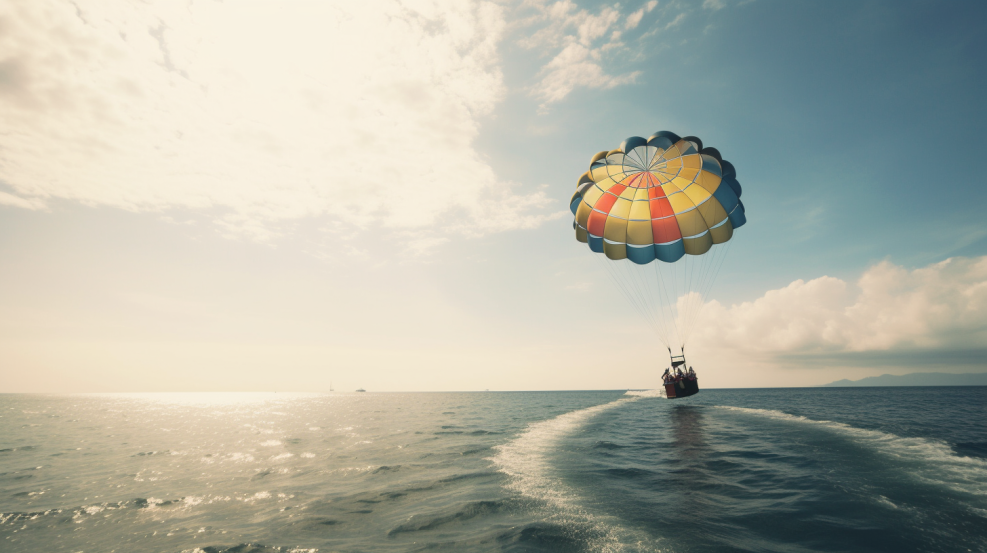Parasailing, an exhilarating recreational activity that combines the thrill of soaring through the air with breathtaking views of the surrounding landscape, has become increasingly popular in coastal and tourist destinations around the world. While this adventure sport offers an unforgettable experience for participants, it is essential to examine its environmental impact to ensure that the joy derived from parasailing does not come at the cost of our fragile ecosystems. This article delves into the environmental implications of parasailing, shedding light on its effects on marine life, coastal ecosystems, air and noise pollution, and the steps that can be taken to minimize its negative consequences.
Parasailing: A Brief Overview
Parasailing involves being harnessed to a parachute-like canopy while being towed by a motorized boat. As the boat gains speed, the parachute lifts the participant into the air, providing a bird’s-eye view of the surroundings. This activity has gained immense popularity due to its accessibility, providing individuals with the opportunity to experience the sensation of flight without the need for special skills or training.
Impact on Marine Life
One of the primary concerns associated with parasailing is its potential impact on marine life. The use of motorized boats to tow participants can disrupt the natural habitats and behaviors of marine animals. The noise generated by these boats can interfere with communication, navigation, and feeding patterns of marine species, particularly dolphins and whales that rely on echolocation. Additionally, the propellers of the boats can pose a direct threat to marine life, causing injuries or even fatalities. The physical presence of the boats and the increased boat traffic in parasailing hotspots can lead to habitat degradation, increased pollution, and potential disturbance of sensitive breeding grounds.
Coastal Ecosystem Disturbances
Parasailing operations are often concentrated in coastal areas, which are ecologically sensitive zones that provide habitat for various species and serve as essential breeding and feeding grounds. The constant movement of parasailing boats near the coast can lead to soil erosion, as the waves generated by these boats can undermine the stability of the shoreline. This erosion can lead to the loss of important habitats such as seagrass beds and coral reefs, affecting the biodiversity of the area. Furthermore, the anchoring and mooring of parasailing boats can damage underwater ecosystems, disrupting delicate balance and leading to long-term degradation.
Air and Noise Pollution
The exhilarating experience of parasailing is accompanied by a significant environmental cost, primarily in the form of air and noise pollution. The motorized boats used for towing release exhaust emissions that contribute to air pollution, releasing harmful gases such as carbon monoxide and nitrogen oxides into the atmosphere. These emissions can have adverse effects on air quality, impacting both human health and the overall environment.
Moreover, the noise generated by the boats can disturb the tranquility of coastal environments, affecting both wildlife and local communities. Noise pollution can disrupt the natural behaviors of marine animals, including communication, mating, and feeding. For coastal residents and visitors seeking solace and relaxation, the constant drone of boat engines can diminish the quality of their experience and erode the cultural value of these areas.
Minimizing the Impact of Parasailing
While the environmental impact of parasailing is concerning, there are steps that can be taken to minimize its negative consequences and promote responsible tourism:
- Regulation and Enforcement: Implementing strict regulations for parasailing operations, including noise limits, restricted operating hours, and designated zones, can help control the environmental impact. Effective enforcement of these regulations is crucial to ensure compliance.
- Technology and Innovation: Exploring alternative, eco-friendly technologies for boats, such as electric or hybrid propulsion systems, can significantly reduce air and noise pollution. These technologies can also mitigate the risk of propeller-related injuries to marine life.
- Education and Awareness: Raising awareness among tourists, operators, and local communities about the potential environmental consequences of parasailing can foster a culture of responsible tourism. Tourists can make informed choices, and operators can adopt sustainable practices.
- Site Selection: Choosing appropriate locations for parasailing operations is vital. Areas with minimal impact on sensitive ecosystems and wildlife should be prioritized. Conducting thorough environmental impact assessments can guide these decisions.
- Collaboration with Conservation Organizations: Collaboration between parasailing operators and conservation organizations can lead to better management practices, including habitat restoration efforts and participation in marine conservation initiatives.
- Research and Monitoring: Continuous research and monitoring of parasailing activities’ environmental impact can provide valuable insights into the effectiveness of mitigation measures and the identification of new challenges.
Conclusion
Parasailing, with its unique blend of excitement and panoramic views, is a testament to human innovation and the desire for adventure. However, the environmental consequences of this popular activity cannot be ignored. As we strive to strike a balance between human enjoyment and environmental stewardship, it is imperative that the parasailing industry takes proactive measures to minimize its ecological footprint. By embracing sustainable practices, adhering to regulations, and fostering a sense of responsibility among operators and tourists alike, we can ensure that parasailing remains a thrilling experience that does not compromise the health and beauty of our planet’s precious ecosystems.

